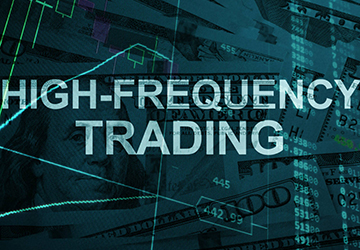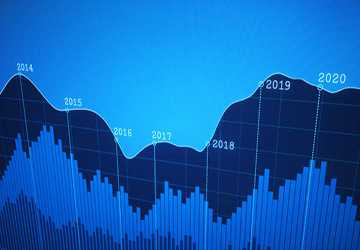In contemporary finance, High-Frequency Trading (HFT) is explained as a colossus, leveraging intricate algorithms to transact securities in mere moments. Although HFT harbours the potential for substantial gains, a profound comprehension of high-frequency trading risks is indispensable for traders and investors.

The Essence of High-Frequency Trading
High-frequency trading amalgamates the prowess of advanced computational technology with complex algorithms to execute voluminous orders at velocities that were once unfathomable. This trading modality is celebrated for its capacity to exploit minuscule discrepancies in price. Nonetheless, a thorough understanding of HFT is paramount for those aspiring to navigate its waters.
Pillars of HFT
● Execution of trades at lightning speed
● Deployment of sophisticated algorithmic strategies
● Analysis of market data in real-time
Navigating the Perils of High-Frequency Trading
The allure of high-frequency trading is undeniable, yet the risks lurk, demanding vigilance and strategy.
Amplification of Market Fluctuations
High-frequency trading can intensify market volatility, with swift trades sometimes leading to pronounced price fluctuations, impacting investors who adopt a more traditional approach.
Systemic Vulnerabilities
The intricate web of global markets means that disturbances in one segment can propagate rapidly. It is critical to grasp the nuances of understanding HFT and its influence on these dynamics.
Dependence on Technological Integrity
Technology is the lifeblood of high-frequency trading; a mere hiccup can unleash a cascade of unintended trades, destabilizing markets.
Perception of Ample Liquidity
High-frequency trading (HFT) may cultivate a deceptive perception of abundant liquidity. Owing to the rapidity with which high-frequency traders can initiate and liquidate positions, the sheer volume of transactions may imply a degree of liquidity absent under standard trading conditions. This presumed liquidity might suddenly vanish during financial turbulence, placing other market actors in precarious situations.
Potential for Market Manipulation
Apprehensions linger that specific HFT methodologies tread perilously close to the boundary of market manipulation. Techniques such as quote stuffing, which involves swiftly placing and retracting numerous orders, can potentially engender distorted market impressions. Regulatory bodies are intensifying their scrutiny of these manoeuvres, albeit their clandestine essence renders them elusive for identification and regulation.
Understanding HFT: Mitigation Strategies and Precautions
In the face of the risks of high-frequency trading, practitioners employ an arsenal of strategies and precautions.
Techniques for Managing Risk
● Implementation of stop-loss commands
● Vigilant real-time surveillance of trades
● Diversification across trading methodologies
Technological Countermeasures
● Integration of algorithmic fail-safes
● Rigorous testing of systems
● Adoption of backup systems to avert operational failures
Ethical Debates
High-frequency trading often finds itself at the centre of ethical debates. Critics point to the potential for an uneven playing field favouring well-resourced firms to the detriment of more minor market participants.
High-Frequency Trading Explained: Visions of the Future
As we gaze into the horizon, high-frequency trading is poised for evolution. It is driven by technological advancements and regulatory scrutiny, ensuring a landscape of fairness.
Prospective Directions
● Enhanced regulatory frameworks
● Evolution in algorithmic trading technologies
● Increased transparency within trading activities
Exploring the Depths of High-Frequency Trading's Influence
The Economic Repercussions of HFT
High-frequency trading (HFT) revolutionizes trading modalities and imprints a lasting impact on the vast economic terrain. Its capability to swiftly modulate financial market liquidity acts as a dual-faceted instrument, providing robustness and potential vulnerability to the monetary framework.
Enhancing Market Fluidity and Efficiency
● A fundamental endorsement of HFT lies in its market fluidity and enhancement of operational efficiency. Narrowing spreads and synchronizing the purchase and sale price points, these swift trades cultivate an environment of enhanced market fluidity.
Equity and Fairness Concerns
● However, beneath the gloss of these technological advancements, a rigorous debate concerning equity simmers. High-frequency trading interrogates established equity norms, igniting discourse on informational accessibility and the velocity of its application, potentially engendering imbalances among market actors.

Ethical and Societal Reflections on HFT
High-frequency trading extends its implications beyond the financial sphere, inciting a broader contemplation of ethical and societal impacts. The interplay between technological progression and societal well-being demands thoughtful deliberation from all stakeholders.
Bridging the Technological Chasm
● The requisite technological sophistication for high-frequency trading accentuates an expanding digital chasm within the financial domain. This division not only segregates substantial financial institutions from smaller market players but also exposes global inequities in technological access within trading arenas.
Reimagining the Future Workforce in Finance
● The ascendancy of high-frequency trading foreshadows transformative shifts in the financial sector's employment landscape. With algorithms gradually assuming functions traditionally performed by humans, the industry is poised for a fundamental transformation, necessitating a reassessment of professional capabilities and roles in the finance ecosystem.
Envisioning the Future Impact of High-Frequency Trading on Global Markets
Diversification and Expansion of HFT Strategies
High-frequency trading (HFT) is set to broaden its horizons, reaching beyond traditional equities into various asset classes. This expansion will likely diversify trading strategies and introduce a new level of complexity and dynamism into global markets.
Integration with Emerging Asset Classes
● The integration of HFT with digital assets, commodities, and fixed-income securities illustrates the diversifying landscape of trading strategies. As HFT algorithms adapt to these new arenas, they bring about nuanced opportunities and challenges for traders and regulators alike.
Cross-Market Strategies and Global Reach
● High-frequency trading is expanding across asset classes and geographical boundaries. This global reach necessitates sophisticated cross-market strategies that can navigate varying regulatory environments and market conditions, further enhancing the interconnectedness of international financial markets.
Conclusion
High-frequency trading, while offering avenues for lucrative returns, demands a careful balance of understanding, strategy, and ethics. Mastery of high-frequency trading and an intimate knowledge of the risks of high-frequency trading are quintessential for those seeking to thrive in this complex domain.
As we look to the future, high-frequency trading stands at the crossroads of innovation and responsibility. Its continued evolution will undoubtedly bring sophisticated strategies and technologies that enhance market efficiency and liquidity. However, the accurate measure of HFT's success will be its ability to integrate these advancements within an ethical framework that promotes transparency, fairness, and inclusivity across global financial markets.



